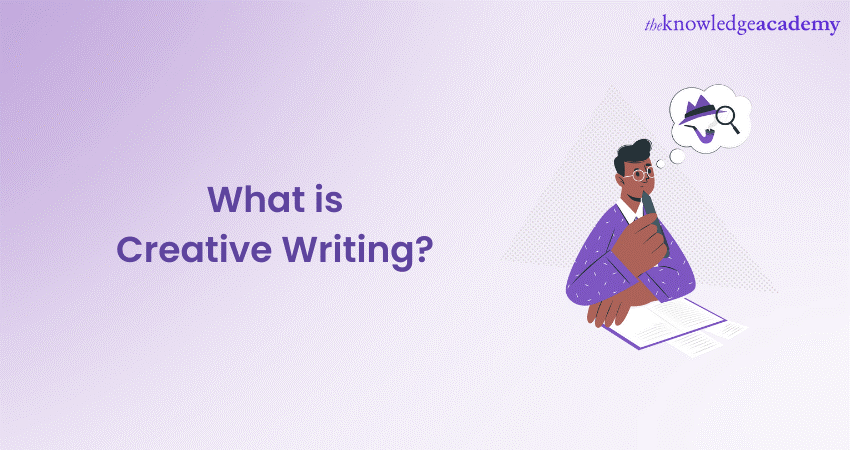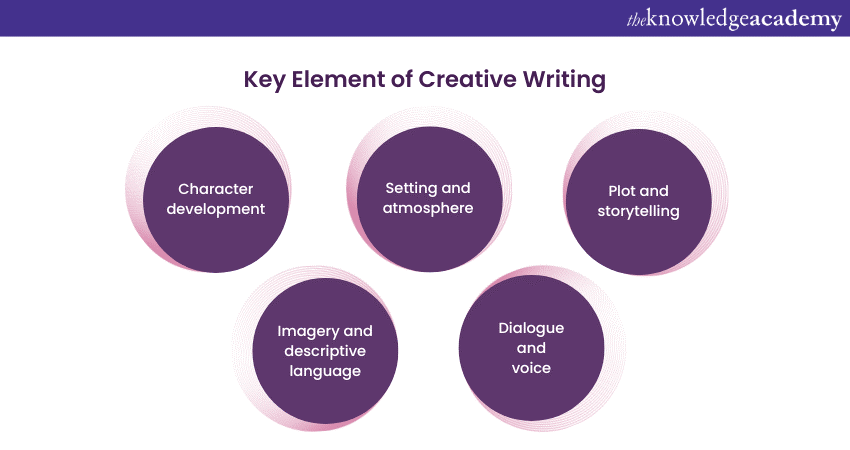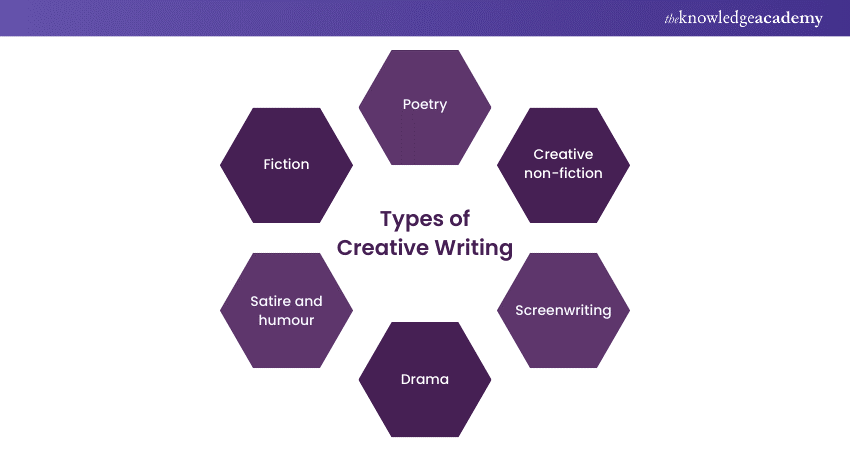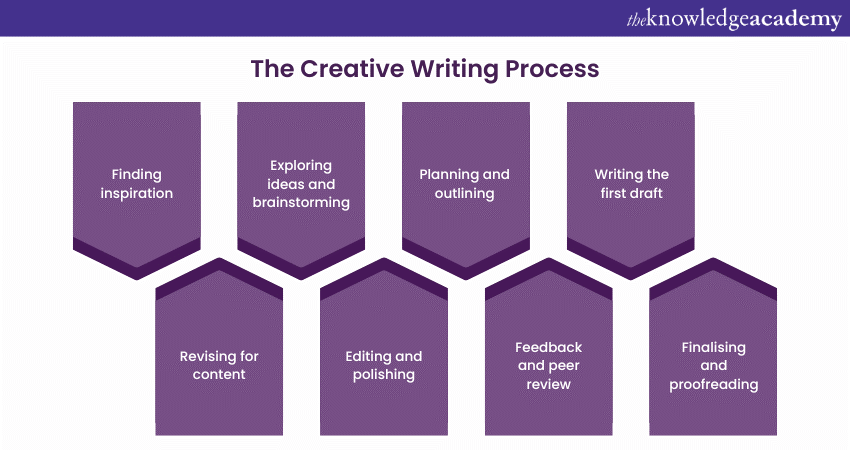We may not have the course you’re looking for. If you enquire or give us a call on 01344203999 and speak to our training experts, we may still be able to help with your training requirements.
Training Outcomes Within Your Budget!
We ensure quality, budget-alignment, and timely delivery by our expert instructors.

There are different types of writing styles. However, if you wish to portray your creativity and create your own story, you need to hone your skills in Creative Writing. thus, it becomes crucial to understand What is Creative Writing?
Creative Writing is a form of art that allows people to express their thoughts, ideas, and emotions through the written word. It is a mode of self-expression that combines imagination with linguistic skills to create compelling narratives, poems, and other forms of literature. A Statista survey found that 76,300 Authors, Writers and Translators work in the United Kingdom alone in 2023. This shows Creative Writing is a demanding career worldwide.To know more about it, read this blog, to learn What is Creative Writing, how to write captivating narratives, and discover the essence of expressive writing.
Table of Contents
1) Understanding What is Creative Writing
2) Key elements of Creative Writing
3) Types of Creative Writing
4) Importance of Creative Writing
5) The Creative Writing process
6) Tips for effective Content Writing
7) Conclusion
Understanding What is Creative Writing
Creative Writing is the art of crafting original content that elicits readers' emotions, thoughts, and imagination. Unlike Academic or Technical Writing, Creative Writing allows for more personal expression and imaginative exploration. It encompasses various forms such as fiction, poetry, non-fiction, and drama, all of which share the common thread of artistic storytelling.
Key elements of Creative Writing
Now that you know the Creative Writing meaning, let’s explore its key elements. They are as follows:

1) Imagery and descriptive language: One of the key ingredients of successful Creative Writing is the use of vivid imagery and descriptive language. By painting a detailed picture with words, Writers can evoke sensory experiences and immerse readers in the story's universe.
2) Character development: Compelling characters are the heart of any great story. Through careful development, characters become relatable, complex, and capable of driving the plot forward.
3) Setting and atmosphere: The setting and atmosphere create the backdrop for the story. By skilfully crafting these elements, Writers can enhance the overall mood and tone, allowing readers to feel like they're living within the story's world.
4) Plot and storytelling: A well-crafted story keeps readers engaged and invested in the narrative's progression. This includes introducing conflicts, building tension, and crafting satisfying resolutions.
5) Dialogue and voice: Dialogue adds authenticity to characters and provides insight into their personalities. A distinctive narrative voice also contributes to the story's uniqueness and captivates readers.
Types of Creative Writing
Creative Writing encompasses various genres and forms, each offering a unique platform for expressing creativity, storytelling, and emotion. As you delve into the world of Creative Writing, it's essential to explore the various types and discover which resonates with you the most. Here are some of the prominent types of Creative Writing:

1) Fiction
Fiction is perhaps the most well-known type of Creative Writing. It involves inventing characters, settings, and plotlines from scratch. Writers have the freedom to create entire worlds and realities, whether they're set in the past, present, future, or even in alternate dimensions.
Novels, short stories, novellas, and flash fiction are all forms of fiction that engage readers through compelling characters, intriguing conflicts, and imaginative settings. From fantasy realms to gritty crime dramas, fiction transports readers to new and exciting places.
2) Poetry
Poetry is the art of condensing language to evoke emotions, provoke thoughts, and communicate complex ideas using rhythm, rhyme, and vivid imagery. Poems' conciseness requires Writers to choose their words carefully, often crafting multiple layers of meaning within a few lines.
Poetry can take various forms, including sonnets, haikus, free verse, and slam poetry. Each form carries its own rules and conventions, allowing Poets to experiment with structure and sound to create impactful compositions. Moreover, poetry delves into the depth of emotions, exploring themes ranging from love and nature to social issues and personal reflections.
3) Creative non-fiction
Non-fiction writing draws from real-life experiences, observations, and research to convey information, insights, and personal perspectives. This form includes genres such as essays, memoirs, biographies, autobiographies, and journalistic pieces.
Non-fiction Writers blend storytelling with factual accuracy, presenting their ideas in a compelling and informative manner. Personal essays offer a glimpse into the writer's thoughts and experiences. At the same time, memoirs and autobiographies share personal journeys and reflections, connecting readers with the author's life story.
4) Drama and playwriting
Playwriting is the creation of scripts for theatrical performances. The challenge lies in crafting engaging dialogue and constructing scenes that captivate both the audience and the performers.
Dramatic Writing requires an understanding of pacing, character motivations, and the visual aspects of storytelling. While Theatrical Writing requires a keen sense of the following:
a) Character dynamics: Building relationships between characters and exploring their motivations and conflicts.
b) Stage directions: Providing clear instructions for actors, directors, and stage designers to bring the play to life.
c) Dramatic structure: Crafting acts and scenes that build tension and engage the audience.
5) Satire and humour
Satire and humour utilise wit, sarcasm, and clever wordplay to critique and mock societal norms, institutions, and human behaviour. This form of Creative Writing often challenges readers to view the world from a different perspective.
Moreover, it encourages them to question established conventions. Satirical works, whether in literature, essays, or satirical news articles, aim to entertain while also prompting reflection on serious topics.
Master Copywriting skills with our Copywriting Course – join today and become an expert Copywriter!
Importance of Creative Writing
Creative Writing holds a profound significance beyond its role as a literary pursuit. It bridges imagination and reality, fostering personal growth, communication skills, and cultural preservation. Here's a closer look at why Creative Writing is of paramount importance:
1) Personal expression and catharsis
Creative Writing is a sanctuary for self-expression. Individuals can voice their innermost thoughts, emotions, and experiences through poetry, stories, and essays. This act of sharing vulnerabilities and joy brings about a cathartic release, offering a therapeutic outlet for emotional expression. Moreover, it cultivates a deeper understanding of oneself, promoting self-awareness and self-acceptance.
2) Cultivation of communication skills
The art of Creative Writing cultivates effective Communication Skills that transcend the written word. Writers learn to convey ideas, concepts, and feelings coherently and captivatingly.
This proficiency extends to verbal communication, enabling Writers to articulate their thoughts with clarity and eloquence. As a result, it enriches interpersonal relationships and professional endeavours.
3) Nurturing empathy and perspective
Writers develop a heightened sense of empathy as they craft diverse characters and explore multifaceted narratives. Immersing oneself in the shoes of different characters fosters understanding and tolerance for various viewpoints and backgrounds. Readers, in turn, experience this empathy, gaining insight into the complexities of human nature and the diverse tapestry of human experience.
4) Exploration of social issues
Writers wield the power to effect change through their words. They can shed light on societal issues, challenge norms, and provoke critical conversations. By addressing topics such as social justice, equality, and environmental concerns, Creative Writing becomes a catalyst for positive transformation and advocacy.
5) Connection and impact
Creative Writing builds bridges between individuals by establishing connections on emotional and intellectual levels. Stories resonate across cultures, transcending geographical and temporal boundaries. The impact of a well-crafted story can be enduring, leaving a mark on readers' hearts and minds.
Unlock your creative potential with our Creative Writing Training - register now!
The Creative Writing process

Creating a compelling piece of Creative Writing is a journey that involves a series of steps, each contributing to the evolution of your story. Whether you're crafting a short story, a novel, or a poem, here's a breakdown of the Creative Writing process in eight essential steps:
1) Finding inspiration
The process begins with a moment of inspiration—a fleeting thought, an intriguing image, or a powerful emotion. Inspiration can strike anywhere—nature, experiences, dreams, or simple observation.
Keep a journal or digital note-taking app to capture these sparks of inspiration as they occur. Explore your interests, passions, and emotions to identify themes and ideas that resonate with you.
2) Exploring ideas and brainstorming
Once you've identified an inspiring concept, delve deeper. Brainstorm ideas related to characters, settings, conflicts, and themes. Jot down all possibilities, allowing your imagination to roam freely. This stage is about generating a wealth of creative options that will serve as building blocks for your story.
3) Planning and outlining
Organise your thoughts by creating an outline. Outline your story's major plot points, character arcs, and pivotal moments. This outline acts as a roadmap, guiding you through the narrative's progression while providing flexibility for creative surprises.
4) Writing the first draft
Once you are done with your outline, start writing your first draft. Don't worry about perfection—focus on getting your ideas onto paper. Let your creativity flow and allow your characters to surprise you. The goal is to have a complete manuscript, even if it's messy and imperfect.
5) Revising for content
Once the first draft is complete, take a step back before revisiting your work. During this stage, focus on revising for content. Analyse the structure of your plot, the development of your characters, and the coherence of your themes. Make necessary changes, add details, and refine dialogue. Ensure that your story's foundation is solid before moving on.
6) Editing and polishing
Edit your Manuscript for grammar, punctuation, sentence structure, and style. Pay attention to clarity and consistency. Also, focus on enhancing the flow of your writing and creating a polished narrative that engages readers.
7) Feedback and peer review
Share your revised work with others—friends, writing groups, or beta readers—to gather feedback. Constructive criticism can highlight blind spots and offer perspectives you might have missed. Use this feedback to refine your work further.
8) Finalising and proofreading
Incorporate the feedback you've received and make final revisions. Proofread meticulously for any remaining errors. Ensure that your work is formatted correctly and adheres to any submission guidelines if you plan to publish or share it.
Tips for effective Creative Writing
Here are some of the useful tips you should consider incorporating in your process of writing :
1) Show, don't tell: Instead of directly stating emotions or details, "showing" involves using actions, thoughts, and dialogue to convey information. This technique allows readers to draw their own conclusions and become more immersed in the story.
2) Use of metaphors and similes: Metaphors and similes offer creative ways to describe complex concepts by comparing them to something familiar. These literary devices add depth and creativity to your writing.
3) Building suspense and tension: By strategically withholding information and creating unanswered questions, Writers can build suspense and keep readers eagerly turning pages.
4) Crafting memorable beginnings and endings: A strong opening captures readers' attention, while a satisfying conclusion leaves a lasting impact. These elements bookend your story and influence readers' overall impression.
5) Experimenting with point of view: The choice of point of view (first person, third person, etc.) shapes how readers experience the story. Experimenting with different perspectives can lead to unique narrative opportunities.
Conclusion
We hope this blog gave you a clear idea of What is Creative Writing, along with its process and useful tips. The Creative Writing process is not linear; you might find yourself revisiting earlier steps as your story evolves. Embrace the journey, allowing your writing to develop and transform through each phase.
Enhance your Academic Writing prowess with our comprehensive Academic Writing Masterclass. - sign up now!
Frequently Asked Questions

a) Literary Agent
b) Screenwriter
c) Video Game Story Writer
d) Copywriter
e) Website Editor
f) Creative Director

There are several resources or recommended readings which can help you to hone your Creative Writing skills. Here we have discussed some of such resources:
a) “On Writing: A Memoir of the Craft" by Stephen King
b) "Bird by Bird: Some Instructions on Writing and Life" by Anne Lamott
c) "Writing Down the Bones: Freeing the Writer Within" by Natalie Goldberg
d) Joining book clubs
e) Reading a variety of authors and genre
f) Practicing writing regular prompts and exercises.

The Knowledge Academy takes global learning to new heights, offering over 30,000 online courses across 490+ locations in 220 countries. This expansive reach ensures accessibility and convenience for learners worldwide.
Alongside our diverse Online Course Catalogue, encompassing 17 major categories, we go the extra mile by providing a plethora of free educational Online Resources like News updates, Blogs, videos, webinars, and interview questions. Tailoring learning experiences further, professionals can maximise value with customisable Course Bundles of TKA.

The Knowledge Academy’s Knowledge Pass, a prepaid voucher, adds another layer of flexibility, allowing course bookings over a 12-month period. Join us on a journey where education knows no bounds.

The Knowledge Academy offers various Personal Development courses, including Organisational skills training, Emotional Intelligence Training, and Report Writing Course. These courses cater to different skill levels, providing comprehensive insights into Journalism.
Our Business Skills blogs covers a range of topics related to Sports Journalism, offering valuable resources, best practices, and industry insights. Whether you are a beginner or looking to advance your Creative Writing skills, The Knowledge Academy's diverse courses and informative blogs have you covered.
Upcoming Business Skills Resources Batches & Dates
Date
 Creative Writing Course
Creative Writing Course
Fri 14th Jun 2024
Fri 30th Aug 2024
Fri 11th Oct 2024
Fri 13th Dec 2024







 Top Rated Course
Top Rated Course



 If you wish to make any changes to your course, please
If you wish to make any changes to your course, please


